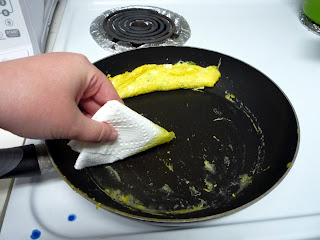That's a box I made for my sister's birthday last year. Salt Salmon, Onigiri rice ball, inari zushi, broccoli and a grape tomato. You can't get simpler with comfort food like this.
So, the main aim of this blog is to start being consistent with making the mini-meals, but I also like to teach a little. (It's the bossy side of me.) I'll be peppering the weeks with tutorials like this one, but I'm not set on a specific day of the week for the lessons. They will just pop up when they do. That said, I'm not pretending this is the definitive guide to bentos. There are tons of sites with interesting pictures and lessons. I'm just showcasing easy methods for items that seem intimidating for a new cook or someone new to Japanese home cooking. Today's will be a feature of getting started in the kitchen and one of the bento staples: the rolled omelet.
A lot of sites are loaded with tasty items that are common Japanese fare, but living in the States in the middle of Nevada, I have a hard time finding half of the "staples." There are a lot of Asian supermarkets that offer some of the seasonings, but you have to know your way around a wok to use them right. Below is a photo of every Japanese item I can come by in a normal grocery store here.
It's not much, but as I grew comfortable with cooking, it made more sense to keep easy staples like these than extensive collections of items that I may use once or twice. I like umeboshi plums, but for someone who doesn't know where to find them, a splash of lemon juice and ginger have the exact same preservation qualities and won't break the bank. In the photo: Calrose rice, white sesame seeds, soy sauce, rice vinegar, black sesame seeds, seaweed (nori), Memmi sauce (a soup base), Inari pockets, and a packet of green tea. These days, we have online access to a lot of foods and spices, but usually, these are expensive and you have to pay shipping. I hear that there are a few decent Asian grocery stores in town, so those might be future field trips. ^.-
Cookware is sort of the same. I have a few fancy cutters, but I rarely cart them out. You can get away with nothing more than a good fruit-paring knife. Here are my tools below.
I have two boxes because I recently started going to school on campus, so the snap-on lid and carry tote were a must, but I've pointed out that tupperware makes just as attractive of a bento box. In all honesty, the most useful item that you might not find is that little plastic colander in the back (light blue). I don't know where my Obaasan (grandmother) got it, but it's excellent for cleaning the rice and veggies. You can make do with a regular colander and bowl, but I love that little thing irrationally.
So, that's pretty much all you need to have a stocked bento kitchen. Not too bad, but before you run out to buy everything, think over some key ideas: What are you making, and what do you need? Usually, it's fun to stock up on stuff, but some of my cutters and the two egg presses (they shape hard boiled eggs into a car or fish) are rarely used. They're fun sometimes things, but using them all the time would wear me down quickly.
Today's box for Bob had to be packed in mine. He left his again.
Teriyaki salmon, Tamagoyaki (rolled omelet), sliced red bell peppers, broccoli and soy bean stir fry, and white rice.
Rolled Omelet or Tamagoyaki is a classic bento food. The egg mixture is slightly sweet and makes for a great added protein without a lot of fat. You'll be wanting to throw this into almost any box, and even alone on a bed of rice, it's a good meal.
Tamagoyaki:
3 eggs
1 tsp sugar
1/2 tbs soy sauce
1/2 tbs rice vinegar
*Optional Add: Green onions, diced bell peppers, Furikake, salmon flakes, shredded cabbage (Mine has green onions today)
1. Beat the ingredients together until the egg mixture is bright yellow but not bubbly.
2. Heat frying pan on medium high and lightly coat with oil, mopping up excess with a paper towel. Reserve the paper towel and oil to wipe between layers.
3. Pour 1/4 egg mixture into the pan and allow to bubble before rolling with spatula.
4. Wipe down pan with paper towel and oil, cleaning the bits.
5. Pour a thin layer of the egg mixture and wait for a thin skin to form over the top or the mixture to bubble.
6. Very carefully, roll the mass of the first layer through the new, lifting gently and allowing the layer to cook to the mass before completing the roll.
7. Repeat steps 4-6 until the egg mixture is rolled up. Remove to a plate to cool.
There you go. Tamagoyaki. Just slice it and serve. Usually, you need a rectangular pan for tamagoyaki, but you can get away with a regular pan with practice. Try it out today. :3









I love Tamagoyaki! I will certainly be using this recipe. @Bob...bring home your bento box! AND More DANNY pictures:)
ReplyDeleteI should have noted that this is the dinner-size recipe. I split this one between two boxes. I'll try to have some Danny pictures. He's not been good about eating what I cook him. Punk.
Delete